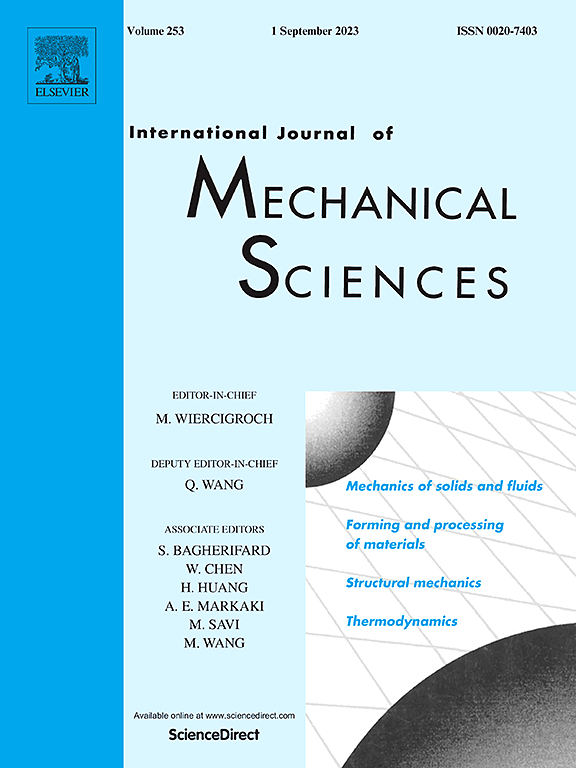Uncertainty analysis of acceleration and velocity fields measured via DIC
IF 7.1
1区 工程技术
Q1 ENGINEERING, MECHANICAL
International Journal of Mechanical Sciences
Pub Date : 2025-07-12
DOI:10.1016/j.ijmecsci.2025.110599
引用次数: 0
Abstract
Digital image correlation is used to obtain full-field displacement measurements in a variety of applications. Since DIC measurements are obtained by comparing digital reconstructions of images captured during an experiment, noise in digital image data will introduce error in the displacement measurements which then propagate into derived field quantities such as displacement gradients, strains, velocity, and acceleration. The propagation of displacement error into velocities and accelerations is of significance in high-rate loading experiments such as direct impact or split Hopkinson pressure bar tests where accurate pointwise velocity and acceleration measurements are important, especially during the early transient stages of loading. While numerous studies have focused on quantifying displacement uncertainty in DIC, displacement uncertainty propagation into the derived velocity and acceleration fields has not been well explored. Employing well-known first and second order differentiation formulae with DIC-measured displacements to determine pointwise velocity and acceleration metrics, the enclosed study presents an error analysis and uncertainty quantification for these field quantities as a function of displacement noise and camera frame rate. When using central difference algorithms, theoretical analysis indicates that (a) uncertainty in acceleration is directly proportional to the product of frame rate squared and standard deviation in displacement and (b) uncertainty in velocity is directly proportional to the product of frame rate and standard deviation in displacement. The uncertainty analysis noted above is supported by results obtained for (a) numerical rigid body translation experiments and (b) a series of both static and wave-induced quasi-rigid motion dynamic experiments where images are obtained using a high-speed camera at frame rates from 100,000 to 5 million frames per second.

DIC测量的加速度和速度场的不确定性分析
在各种应用中,数字图像相关被用于获得全场位移测量。由于DIC测量是通过比较实验期间捕获的图像的数字重建来获得的,因此数字图像数据中的噪声将在位移测量中引入误差,然后传播到导出的场量,如位移梯度,应变,速度和加速度。位移误差转化为速度和加速度的传播在高速率加载实验中具有重要意义,例如直接冲击或劈裂霍普金森压杆试验,在这些实验中,精确的点向速度和加速度测量非常重要,特别是在加载的早期瞬态阶段。虽然许多研究都集中在量化DIC中的位移不确定性,但位移不确定性在导出的速度和加速度场中的传播尚未得到很好的探讨。本文采用著名的一阶和二阶微分公式,用dic测量的位移来确定点向速度和加速度指标,并对这些场量作为位移噪声和相机帧率的函数进行误差分析和不确定性量化。在使用中心差分算法时,理论分析表明:(a)加速度的不确定性与帧率平方与位移标准差的乘积成正比;(b)速度的不确定性与帧率与位移标准差的乘积成正比。上述不确定性分析得到以下结果的支持:(a)数值刚体平移实验和(b)一系列静态和波动诱导的准刚性运动动态实验,其中图像是使用高速摄像机以每秒10万至500万帧的帧率获得的。
本文章由计算机程序翻译,如有差异,请以英文原文为准。
求助全文
约1分钟内获得全文
求助全文
来源期刊

International Journal of Mechanical Sciences
工程技术-工程:机械
CiteScore
12.80
自引率
17.80%
发文量
769
审稿时长
19 days
期刊介绍:
The International Journal of Mechanical Sciences (IJMS) serves as a global platform for the publication and dissemination of original research that contributes to a deeper scientific understanding of the fundamental disciplines within mechanical, civil, and material engineering.
The primary focus of IJMS is to showcase innovative and ground-breaking work that utilizes analytical and computational modeling techniques, such as Finite Element Method (FEM), Boundary Element Method (BEM), and mesh-free methods, among others. These modeling methods are applied to diverse fields including rigid-body mechanics (e.g., dynamics, vibration, stability), structural mechanics, metal forming, advanced materials (e.g., metals, composites, cellular, smart) behavior and applications, impact mechanics, strain localization, and other nonlinear effects (e.g., large deflections, plasticity, fracture).
Additionally, IJMS covers the realms of fluid mechanics (both external and internal flows), tribology, thermodynamics, and materials processing. These subjects collectively form the core of the journal's content.
In summary, IJMS provides a prestigious platform for researchers to present their original contributions, shedding light on analytical and computational modeling methods in various areas of mechanical engineering, as well as exploring the behavior and application of advanced materials, fluid mechanics, thermodynamics, and materials processing.
 求助内容:
求助内容: 应助结果提醒方式:
应助结果提醒方式:


